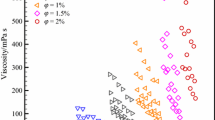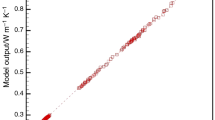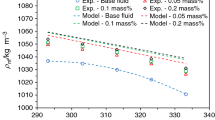Abstract
Research shows that due to enhanced properties IoNanofluids have the potential of being used as heat transfer fluids (HTFs). A significant amount of experimental work has been done to determine the thermophysical and rheological properties of IoNanofluids; however, the number of intelligent models is still limited. In this work, we have experimentally determined the thermal conductivity and viscosity of MXene-doped [MMIM][DMP] ionic liquid. The size of the MXene nanoflakes was determined to be less than 100 nm. The concentration was varied from 0.05 mass% to 0.2 mass%, whereas the temperature varied from 19 °C to 60 °C. The maximum thermal conductivity enhancement of 1.48 was achieved at 0.2 mass% and 30 °C temperature. For viscosity, the maximum relative viscosity of 1.145 was obtained at 0.2 mass% and 23 °C temperature. After the experimental data for thermal conductivity and viscosity were obtained, two multiple linear regression (MLR) models were developed. The MLR models’ performances were found to be poor, which further called for the development of more accurate models. Then two feedforward multilayer perceptron models were developed. The Levenberg–Marquardt algorithm was used to train the models. The optimum models had 4 and 10 neurons for thermal conductivity and viscosity model, respectively. The values of statistical indices showed the models to be well-fit models. Further, relative deviations values were also accessed for training data and testing data, which further showed the models to be well fit.
















Similar content being viewed by others
Data Availability
The datasets used and analyzed during the current study are available from the corresponding author on reasonable request.
Abbreviations
- HTF:
-
Heat transfer fluid
- IL:
-
Ionic liquid
- NEIL:
-
Nanoparticle-enhanced ionic liquid
- INF:
-
IoNanofluid
- MWCNTs:
-
Multiwalled carbon nanotubes
- GNP:
-
Graphene nanoplatelets
- EG:
-
Ethylene glycol
- ANFIS:
-
Adaptive neuro fuzzy inference system
- ARD:
-
Average relative deviation
- ANN:
-
Artificial neural network
- SVR:
-
Support vector regression
- MLR:
-
Multiple linear regression
- LM:
-
Levenberg–Marquardt
- MSE:
-
Mean square error
- MAE:
-
Mean absolute error
- RD:
-
Relative deviation
- TCR:
-
Thermal conductivity ratio
- RV:
-
Relative viscosity
References
D. Wen, G. Lin, S. Vafaei, K. Zhang, Review of nanofluids for heat transfer applications. Particuology 7, 141–50 (2009)
C.A. Nieto de Castro, M.J.V. Lourenço, A.P.C. Ribeiro, E. Langa, S.I.C. Vieira, P. Goodrich, C. Hardacre, Thermal properties of ionic liquids and IoNanofluids of imidazolium and pyrrolidinium liquids. J. Chem. Eng Data 55, 653–61 (2010)
S.U.S. Choi, J.A. Eastman, Enhancing thermal conductivity of fluids with nanoparticles. ASME Fluids Eng Div. 231, 99–105 (1995)
M.A. Nazari, M.H. Ahmadi, M. Sadeghzadeh, M.B. Shafii, M. Goodarzi, A review on application of nanofluid in various types of heat pipes. J Cent. South Univ. 26, 1021–41 (2019)
I.A. Qeays, S.M. Yahya, M. Asjad, Z.A. Khan, Multi-performance optimization of nanofluid cooled hybrid photovoltaic thermal system using fuzzy integrated methodology. J Clean. Prod. 256, 120451 (2020)
I.A. Qeays, S.M. Yahya, M.S.B. Arif, A. Jamil, Nanofluids application in hybrid photovoltaic thermal system for performance enhancement: a review. AIMS Energy 8, 365–93 (2020)
N. Ali, J.A. Teixeira, A. Addali, A review on nanofluids: fabrication, stability, and thermophysical properties. J Nanomater. 2018, 6978130 (2018)
L. Qiu et al., A review of recent advances in thermophysical properties at the nanoscale: from solid state to colloids. Phys. Rep. 843, 1–81 (2020)
S.K. Singh, A.W. Savoy, Ionic liquids synthesis and applications: an overview. J. Mol. Liq. 297, 112038 (2020)
A.A. Minea, S.M.S. Murshed, A review on development of ionic liquid based nanofluids and their heat transfer behavior. Renew. Sustain. Energy Rev. 91, 584–99 (2018)
R.D. Rogers, K.R. Seddon, Ionic liquids-solvents of the future? Science 302, 792–3 (2003)
K. Paduszyński, U. Domańska, Viscosity of ionic liquids: an extensive database and a new group contribution model based on a feed-forward artificial neural network. J. Chem. Inf. Model. 54, 1311–24 (2014)
J.F. Wishart, Energy applications of ionic liquids. Energy Environ. Sci. 2, 956–61 (2009)
R. Ratti, Ionic liquids: synthesis and applications in catalysis. Adv. Chem. 2014, 729842 (2014)
R.L. Vekariya, A review of ionic liquids: applications towards catalytic organic transformations. J. Mol. Liq. 227, 44–60 (2017)
W. Dai, W. Yang, Y. Zhang, D. Wang, X. Luo, X. Tu, Novel isothiouronium ionic liquid as efficient catalysts for the synthesis of cyclic carbonates from CO\(_{2}\) and epoxides. J. Carbondioxide Util. 17, 256–262 (2017)
N. Sugihara, K. Nishimura, H. Nishino, S. Kanehashi, K. Mayumi, Y. Tominaga, T. Shimomura, K. Ito, Ion-conductive and elastic slide-ring gel Li electrolytes swollen with ionic liquid. Electro Acta. 229, 166–72 (2017)
E.A. Chernikova, L.M. Glukhov, V.G. Krasovskiy, L.M. Kustov, M.G. Vorobyeva, A.A. Koroteev, Ionic liquids as heat transfer fluids: comparison with known systems, possible applications, advantages and disadvantages. Russ. Chem. Rev. 84, 875–90 (2015)
V.V. Wadekar, Ionic liquids as heat transfer fluids—an assessment using industrial exchanger geometries. Appl. Therm. Eng. 111, 1581–7 (2017)
M. Watanabe, M.L. Thomas, S. Zhnag, K. Ueno, T. Yasuda, K. Dokko, Application of ionic liquids to energy storage and conversion materials and devices. Chem. Rev. 117, 7190–239 (2017)
J.M.P. França, M.J.V. Lourenço, S.M.S. Murshed, A.A.H. Pádua, C.A. de Nieto Castro, Thermal conductivity of ionic liquids and ionanofluids and their feasibility as heat transfer fluids. Indus Eng. Chem. Res. 57, 6516–29 (2018)
F.F. Zhang, F.F. Zheng, X.H. Wu, Y.L. Yin, G. Chen, Variations of thermophysical properties and heat transfer performance of nanoparticle-enhanced ionic liquids. R. Soc. Open Sci. 6, 182040 (2019)
B. Bakthavatchalam, K. Habib, R. Saidur, B.B. Saha, K. Irshad, Comprehensive study on nanofluid and ionanofluid for heat transfer enhancement: a review on current and future perspective. J. Mol. Liq. 305, 112787 (2020)
A.A. Minea, Overview of ionic liquids as candidates for new heat transfer fluids. Int. J. Thermophys. 41, 151 (2020)
G. Huminic, A. Huminic, Heat transfer capability of ionanofluids for heat transfer applications. Int. J. Thermophys. 42, 12 (2020)
E.I. Cherecheş, J.I. Prado, M. Cherecheş, A.A. Minea, L. Lugo, Experimental study on thermophysical properties of alumina nanoparticle enhanced ionic liquids. J. Mol. Liq. 291, 111332 (2019)
T.C. Paul, A.K.M.M. Morshed, E.B. Fox, J.A. Khan, Thermal performance of Al\(_{2}\)O\(_{3}\) Nanoparticle Enhanced Ionic Liquids (NEILs) for Concentrated Solar Power (CSP) applications. Int. J. Heat Mass Transf. 85, 585–94 (2015)
T.C. Paul, A.K.M.M. Morshed, J.A. Khan, Nanoparticle enhanced ionic liquids (NEILs) as working fluid for the next generation solar collector. Procedia Eng. 56, 631–6 (2013)
F. Wang, L. Han, Z. Zhang, X. Fang, J. Shi, W. Ma, Surfactant-free ionic liquid-based nanofluids with remarkable thermal conductivity enhancement at very low loading of graphene. Nano Res. Lett. 7, 314 (2012)
H. Xie, Z. Zhao, J. Zhao, H. Gao, Measurement of thermal conductivity, viscosity and density of ionic liquid [EMIM][DEP]-based nanofluids. Chin. J. Chem. Eng. 24, 331–8 (2016)
R.M. Ronchi, J.T. Arantes, S.F. Santos, Synthesis, structure, properties and applications of MXenes: current status and perspectives. Ceram. Int. 45, 18167–88 (2019)
Z. Bao, N. Bing, X. Zhu, H. Xie, W. Yu, Ti3C2Tx MXene contained nanofluids with high thermal conductivity, super colloidal stability and low viscosity. Chem. Eng. J. (2020). https://doi.org/10.1016/j.cej.2020.126390
N. Aslfattahi, L. Samylingam, A.S. Abdelrazik, A. Arifutzzaman, R. Saidur, MXene based new class of silicone oil nanofluids for the performance improvement of concentrated photovoltaic thermal collector. Solar Energy Mater. Solar Cells. 211, 110526 (2020)
D. Toghraie, M.H. Aghahadi, N. Sina, F. Soltani, Application of Artificial Neural Networks (ANNs) for predicting the viscosity of tungsten oxide (WO3)-MWCNTs/engine oil hybrid nanofluid. Int. J. Thermophys. 41, 163 (2020)
M. Sadi, Prediction of thermal conductivity and viscosity of ionic liquid based nanofluid using adaptive neuro fuzzy inference system. Heat Transf. Eng. 38, 1561–72 (2017)
L. Das, K. Habib, R. Saidur, N. Aslfattahi, S.M. Yahya, F. Rubbi, Improved thermophysical properties and energy efficiency of aqueous ionic liquid/MXene nanofluid in a hybrid PV/T solar system. Nanomaterials 10, 1372 (2020)
S. Rostami, R. Kalbasi, N. Sina, A.S. Goldanlou, Forecasting the thermal conductivity of a nanofluid using artificial neural networks. J. Therm. Anal. Calorim. (2020). https://doi.org/10.1007/s10973-020-10183-2
M. Bahiraei, S. Nazari, H. Moayedi, H. Safarzadeh, Using neural network optimized by imperialist competition method and genetic algorithm to predict water productivity of a nanofluid-based solar still equipped with thermoelectric modules. Powder Technol. 366, 571–86 (2020)
B. Paknezhad, M. Vakili, M. Bozorgi, M. Hajialibabaie, M. Yahyaei, A hybrid genetic-BP algorithm approach for thermal conductivity modeling of nanofluid containing silver nanoparticles coated with PVP. J. Therm. Anal. Calorim. (2020). https://doi.org/10.1007/s10973-020-09989-x
H. Kalani, M. Sardarabadi, M. Passandideh-Fard, Using artificial neural network models and particle swarm optimization for manner prediction of a photovoltaic thermal nanofluid based collector. Appl. Therm. Eng. 113, 1170–7 (2017)
M.R.H. Jirandeh, M. Mohammadiun, H. Mohammadiun, M.H. Dubaie, M. Sadi, Intelligent modeling of rheological and thermophysical properties of nanoencapsulated PCM slurry. Heat Transf. 49, 2080–102 (2020)
C.C. Li, N.Y. Hau, Y. Wang, A.K. Soh, S.P. Feng, Temperature-dependent effect of percolation and Brownian motion on the thermal conductivity of TiO2-ethanol nanofluids. Phys. Chem. Chem. Phys. 18, 15363–8 (2016)
M.U. Sajid, H.M. Ali, Thermal conductivity of hybrid nanofluids: a critical review. Int. J. Heat Mass Transf. 126, 211–34 (2018)
A.D. Zadeh, D. Toghraie, Experimental investigation for developing a new model for the dynamic viscosity of silver/ethylene glycol nanofluid at different temperatures and solid volume fractions. J. Therm. Anal. Calorim. 131, 1449–61 (2018)
F. Jabbari, A. Rajabpour, S. Saedodin, Viscosity of carbon nanotube/water nanofluid. J. Therm. Anal. Calorim. 135, 1787–96 (2019)
N. Parashar, N. Aslfattahi, S.M. Yahya, R. Saidur, An artificial neural network approach for the prediction of dynamic viscosity of MXene-palm oil nanofluid using experimental data. J. Therm. Anal. Calorim. (2020). https://doi.org/10.1007/s10973-020-09638-3
Author information
Authors and Affiliations
Contributions
NP: Modeling, Draft editing, Typesetting; NA: Experimental analysis, Draft editing; SMY: Draft editing, Proofreading, Supervision; RS: Draft editing, Proofreading, Supervision.
Corresponding author
Ethics declarations
Conflict of interest
The authors declare that they have no competing interest.
Additional information
Publisher's Note
Springer Nature remains neutral with regard to jurisdictional claims in published maps and institutional affiliations.
This article is part of the Special Issue on Nanoparticle-enhanced Ionic Liquids.
Rights and permissions
About this article
Cite this article
Parashar, N., Aslfattahi, N., Yahya, S.M. et al. ANN Modeling of Thermal Conductivity and Viscosity of MXene-Based Aqueous IoNanofluid. Int J Thermophys 42, 24 (2021). https://doi.org/10.1007/s10765-020-02779-5
Received:
Accepted:
Published:
DOI: https://doi.org/10.1007/s10765-020-02779-5




